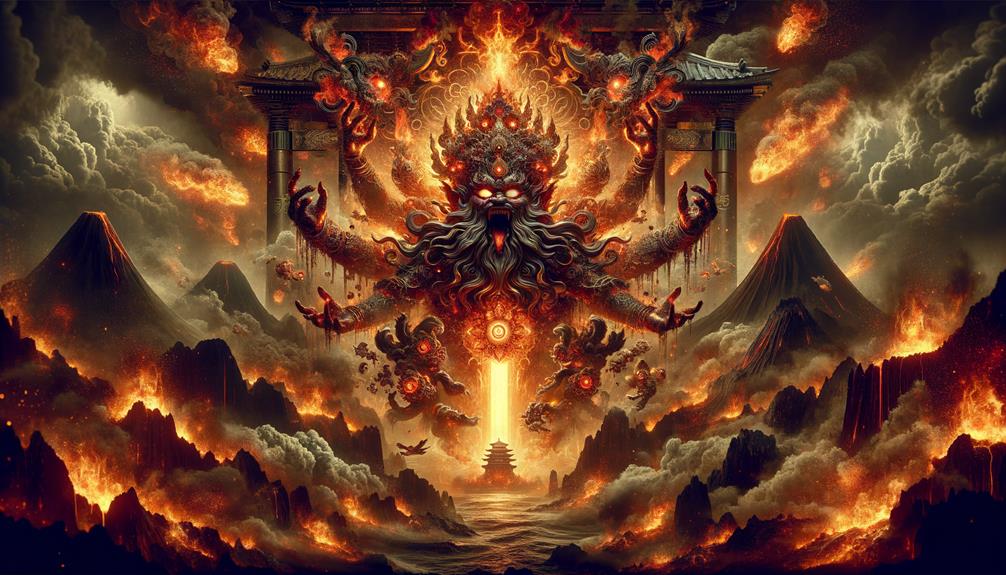Kagutsuchi’s fiery arrival captivated Japan’s mythology, igniting volcanic eruptions and tragically claiming his mother Izanami’s life. Yet, from his remains emerged new deities – a profound reminder of existence’s cyclical nature. This myth echoes familiar motifs: life, death, rebirth. Beneath its dramatic surface lie deeper truths about creation and destruction’s duality.
We’re intrigued by how one turbulent event sparked transformation in both celestial and earthly realms. Kagutsuchi’s birth exemplifies the thin line separating beginnings from endings. His manifestation enabled new life forms while snuffing out another. This duality invites contemplation on the complex, often paradoxical forces shaping our world.
Contemporary thinkers may interpret Kagutsuchi’s story through diverse lenses – religious, philosophical, or scientific. Some might perceive it as an allegory for humanity’s capacity to create and destroy in equal measure. Others could view it as an ancient explanation for volcanic activity’s creative yet devastating impacts. Whichever perspective one adopts, this saga compels us to ponder our role in nature’s perpetual cycle of renewal.
Mythological Origins
Kagutsuchi’s explosive arrival in Japanese mythology holds immense significance, born from Izanagi’s desperate attempt at purification. As the fire deity, Kagutsuchi’s birth wasn’t a simple event but a cataclysm reshaping the divine narrative. His emergence tragically led to his mother Izanami’s demise, unable to withstand the fiery intensity. This profound loss paved Kagutsuchi’s destiny while highlighting fire’s potent and often destructive nature.
Izanami and Izanagi, primal deities, created Japan’s islands and countless kami. However, their son Kagutsuchi marked a pivotal turn. The fire god’s arrival encapsulates creation and destruction’s cycles, underscoring the eternal dance of opposing forces. His birth was both marvelous and cursed, catalyzing events forever altering the divine pantheon.
Exploring Kagutsuchi’s origins illuminates the profound duality within Japanese mythology – life and death’s delicate balance, creation juxtaposed with destruction. His tale demonstrates the eternal interplay of opposing energies, shaping the world and its celestial inhabitants.
The Birth of Kagutsuchi
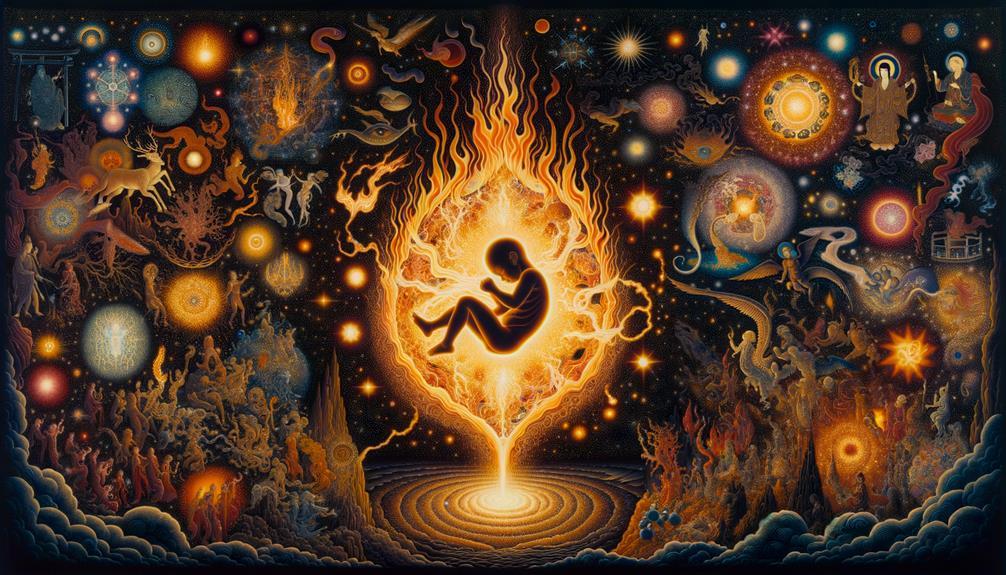
Kagutsuchi’s birth wasn’t just another incident; it marked a seismic shift in the celestial and mortal realms. Emerging from Izanami, the Japanese goddess of creation, Kagutsuchi’s arrival triggered an intense surge of fire that tragically claimed his mother’s life, introducing death into Japanese mythology.
Overwhelmed with grief and anger, Izanagi, Kagutsuchi’s father, beheaded him, setting off a transformative chain of events:
- Volcanoes: Eight volcanoes erupted from Kagutsuchi’s severed body, embodying the earth’s fiery core.
- New Deities: Kagutsuchi’s blood and remains gave rise to new gods, like Watatsumi and Futsunushi, highlighting creation’s cyclical nature.
- Sacrifice: This myth underscores sacrifice, as Kagutsuchi’s birth brought both creation and destruction.
- Fire’s Duality: Fire, represented by Kagutsuchi, symbolizes life-giving warmth and devastating power.
Kagutsuchi’s origin narrative powerfully illustrates the complex interplay between creation, death, and rebirth within Japanese mythology. His fiery essence reminds us of life’s dualistic nature.
Consequences of His Birth
From when Kagutsuchi’s flames engulfed his mother, the world transformed forever, sparking a saga of decimation and renewal. Grief-stricken and enraged, Izanagi severed Kagutsuchi’s head, unleashing even greater forces. Every fragment of the fire god’s body manifested as volcanic upheavals, crystallizing the cycle of creation and destruction central to Japanese mythology.
This earth-shattering event birthed deities Watatsumi and Takemikazuchi, representing life emerging from death’s duality. These two would later embody pivotal aspects of Japanese culture – fire fighting and balancing chaos with order.
| Event | Consequence |
|---|---|
| Kagutsuchi’s birth | Izanami’s demise |
| Izanagi’s wrath | Decapitating Kagutsuchi |
| Kagutsuchi’s fragmentation | Volcanic eruptions |
| Emergence of new gods | Watatsumi and Takemikazuchi born |
Ancient texts like the Engishiki describe rituals to pacify Kagutsuchi, underscoring the need to control his volatility. This narrative echoes universal themes of loss, transformation, and creation-destruction’s endless interplay. Through Japan’s cultural lens, Kagutsuchi’s birth and dismemberment reflect fire’s peril and promise – an eternal force demanding reverence.
Symbolism and Significance
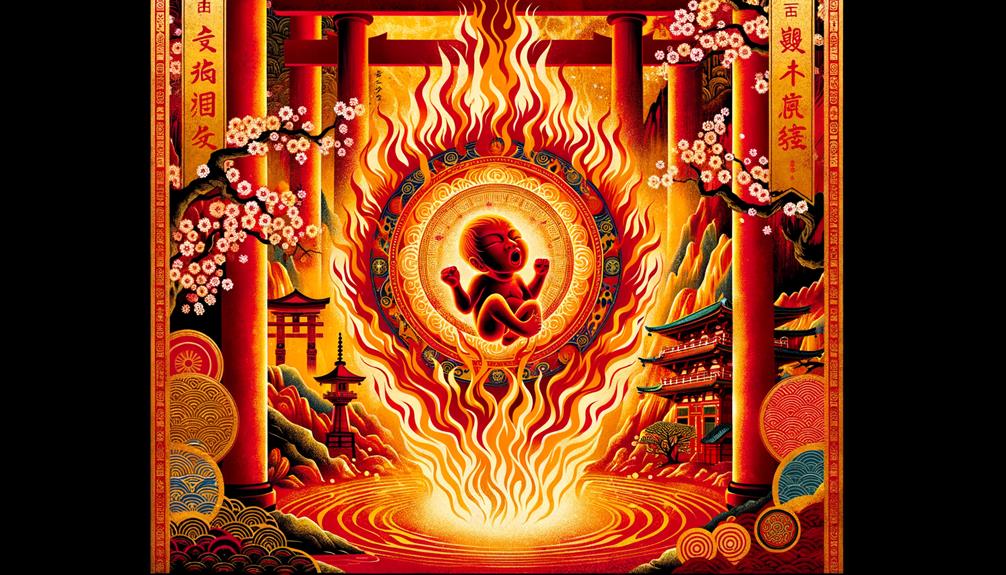
The fiery essence of Kagutsuchi, the Japanese god of fire, embodies both creation and destruction, igniting a story of rebirth woven into mythology. His birth and death at his father Izanagi’s hands highlight themes of tragedy and sacrifice, reinforcing how life and death intertwine.
Kagutsuchi’s influence extends beyond myth, permeating Japanese culture through volcanic eruptions and flames’ transformative power. Four key elements underscore his importance:
- Duality: Fire creates and destroys, a powerful reminder of its ability to forge new beginnings or bring devastating ends.
- Transformation: Flames purify and renew, reflecting Kagutsuchi’s role in life and death cycles.
- Artisan Respect: Craftspeople and weapon makers honor Kagutsuchi, acknowledging his influence on their creative processes.
- Regeneration: Depicted fiercely, Kagutsuchi embodies destruction leading to unending rebirth cycles.
Kagutsuchi’s legacy pays tribute to fire’s transformative power, forever shaping and reshaping the world left behind.
Depictions in Popular Culture
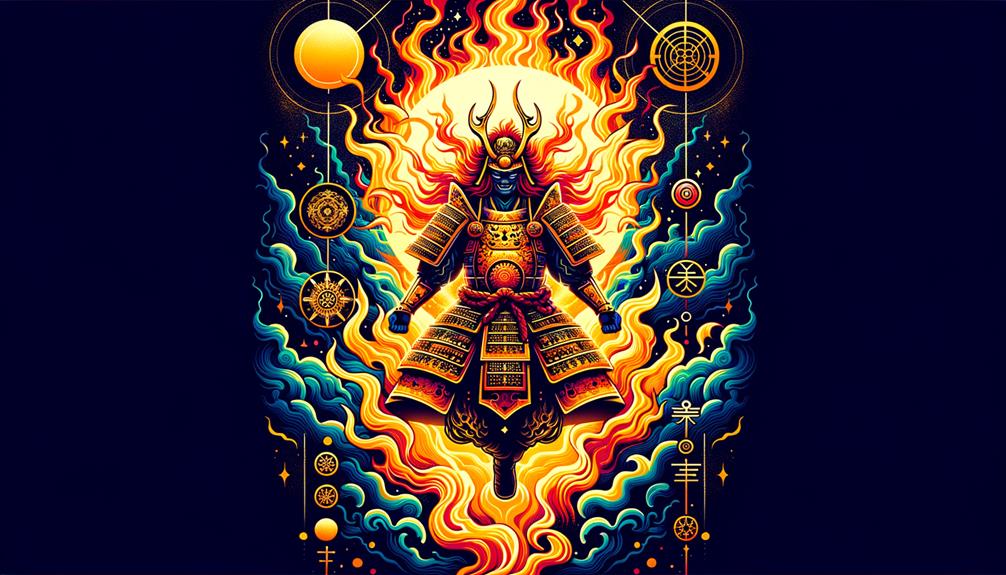
As I delve into anime and manga universes, Kagutsuchi’s fiery essence shines, symbolizing creation and ruin. Games like ‘Naruto’ portray his black flames, showcasing formidable power. These portrayals capture mythological origins while resonating with universal themes of strength and transformation. The tales explore Kagutsuchi’s dual nature – harbinger of rebirth and agent of destruction – in an entrancing manner that grips audiences worldwide. Anime enthusiasts find themselves captivated by the folklore reimagined through vivid visuals and compelling narratives.
Anime and Manga References
Anime and manga frequently intertwine narratives with Kagutsuchi’s fiery essence, forging characters and techniques that channel the god’s destructive power and mythological significance. These depictions reveal a rich tapestry of fire-themed abilities echoing his ancient legend. Kagutsuchi symbolizes rebirth and destruction, a recurrent theme in stories exploring the hero’s journey and mythological archetypes.
Noteworthy instances include Sasuke Uchiha’s Amaterasu and Kagutsuchi techniques in Naruto: Shippuden, manipulating black flames with devastating effect, embodying the god’s destructive nature. Hino Rei, Sailor Mars in Sailor Moon, showcases her fire-based powers, reflecting Kagutsuchi’s fiery essence and mythological roots. Zancrow, a Grimoire Heart member in Fairy Tail, wields God Slayer Magic, including fire-based attacks channeled from Kagutsuchi’s mythos. Noragami directly references Kagutsuchi’s background, weaving his symbolic power into the storyline, enriching the narrative with cultural depth.
These modern storytelling representations bridge ancient mythology, resonating with universal themes of power, transformation, and the eternal struggle between creation and destruction.
Video Game Appearances
Video games embrace Kagutsuchi‘s fiery essence, the Shinto God of Fire, as a formidable antagonist. Titles like ‘Shin Megami Tensei‘ and ‘Persona 4‘ feature him as a boss, his destructive power challenging players. In ‘Okami,’ he transforms into a dragon spewing Japanese fire, honoring his elemental might.
Kagutsuchi’s appearances often highlight his links to fire and volcanoes, reflecting his dual nature – life-giving yet destructive. ‘Smite’ depicts him as a raw, untamed flame entity, while ‘Destiny of Spirits’ portrays his fiery wrath as a gameplay focus.
Throughout games, Kagutsuchi’s fiery origins as the Shinto Fire God shine, whether as a foe to vanquish or an ally’s power. His legacy burns bright in this medium.
Legacy in Japanese Folklore
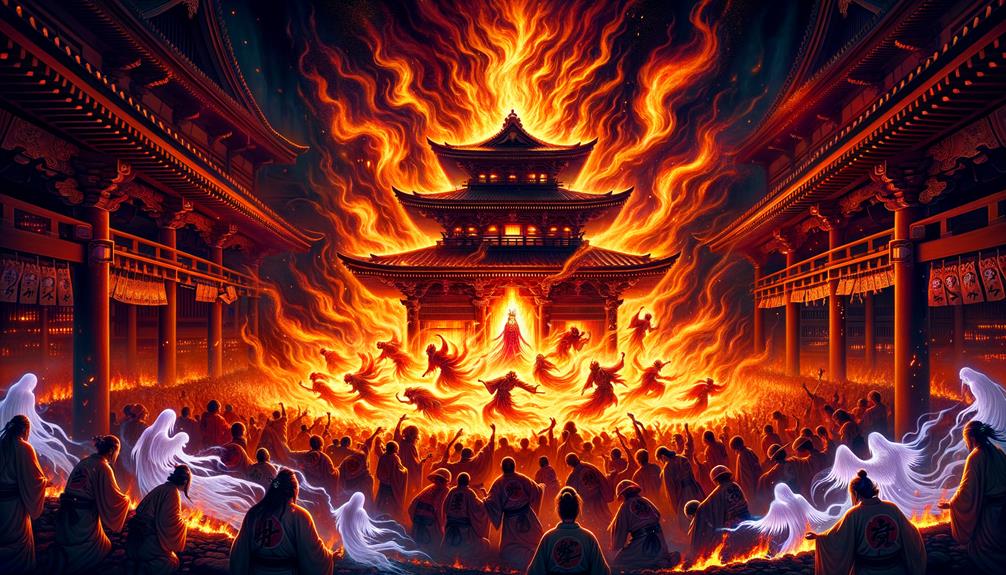
Kagutsuchi’s legacy in Japanese folklore captivates, his tale surpassing a tragic beginning and end to symbolize the perpetual interplay between creation and destruction. His mythological significance, evident in Japan’s volcanic formations, reflects nature’s enduring cycles. Over time, cultural depictions evolved, ensuring his fiery spirit endures through contemporary interpretations.
Mythological Significance Explained
The mythical birth of Kagutsuchi interweaves creation, destruction, and transformation into a captivating Japanese folktale. As the fire deity, Kagutsuchi’s arrival marked a pivotal moment. His emergence from Izanami’s passing symbolized life’s cyclical nature. When Izanagi slew Kagutsuchi in grief, the god’s fiery remains formed eight volcanoes, forever altering the natural landscape.
Kagutsuchi’s tale brims with archetypal mythological themes ingrained in Japanese culture:
- Duality: His fire brings life yet also heralds death, embodying creation and destruction’s dual nature.
- Natural Forces: Volcanoes stemming from his body highlight his integral role in the environment.
- Divine Interconnectedness: Deities like Watatsumi and Takemikazuchi arising from his remains showcase the mythos’ interlinked divine beings.
- Reverence and Rituals: The Engishiki’s measures to pacify Kagutsuchi underscore the respect and trepidation surrounding his volatile power.
Through these elements, Kagutsuchi’s enduring legacy as Japan’s fire and volcano god burns brilliantly within its cultural fabric.
Cultural Depictions Over Time
Across centuries, Kagutsuchi’s fiery tale burns bright through Japanese folklore, fusing creation with destruction in stories that mirror the hero’s path and archetypal myths. From his tempestuous birth to his pivotal role in Shinto beliefs, Kagutsuchi embodies duality – life and death, creation and chaos. Ancient texts like the Records of Ancient Matters immortalize his essence, portraying Kagutsuchi as an object of fear and reverence.
His influence transcends ancient scrolls, manifesting in various Japanese art forms and media. Artisans working with fire, such as blacksmiths and potters, call upon Kagutsuchi for protection and creative sparks, intertwining their craft with his mythic presence. His image adapts to modern video games too, retaining an enigmatic aura and commanding presence.
| Aspect | Description |
|---|---|
| Shinto Beliefs | Venerated as a fire deity, symbolizing creation and destruction |
| Ancient Texts | Documented in writings like Records of Ancient Matters, depicting life’s cycles |
| Japanese Artforms | Featured across art mediums, invoked by fire artisans |
| Video Games | Contemporary depictions keep his legend alive, inspiring audiences |
Kagutsuchi’s enduring legacy in folklore and modern reimaginings underscores universal themes of transformation and balance, cementing him as a timeless figure in Japanese mythology.
Modern Interpretations Influence
Kagutsuchi’s fiery essence ignites new worlds in countless modern stories, acting as a catalyst for creation and destruction. The Japanese remain captivated by his myth, weaving it into contemporary narratives in innovative ways.
Manga artists often depict Kagutsuchi as a fearsome dragon or powerful elemental being, embodying his fiery spirit. Video game characters inspired by him frequently possess fire-based powers, reflecting his destructive and creative capabilities. Anime storylines explore themes of balance between creation and destruction, drawing directly from his mythological roots. Modern authors integrate his legacy into their tales, using his archetype to delve into universal themes of rebirth and transformation.
These fresh interpretations shape how audiences connect with Kagutsuchi’s tale today. By reimagining his myth in new contexts, creators ensure his story burns brightly across generations.
Frequently Asked Questions
What Does Kagutsuchi Symbolize?
Kagutsuchi symbolizes the dynamic duality of creation and destruction found in mythological tales. This fire deity embodies the transformative energy of flames, representing themes like rebirth, sacrifice, and the cyclical nature of life through both chaotic and renewing forces.
Who Is Kagutsuchi the Japanese God of Destructive Fire?
Kagutsuchi, the fiery deity, encapsulates both creation and chaos. His scorching essence sparks life yet leaves trails of ruin, continually reshaping our world. Revered yet feared, he represents transformation, sacrifice, and the eternal cycle of rebirth unfolding around us.
What Happened to Izanami After Giving Birth to the God of Fire?
After giving birth to the fire god, I, Izanami, experienced severe burns that tragically led to my demise. This pivotal event paved the way for a profound journey, ushering in new deities and reshaping Japan’s mythological landscape. My passing marked a transformative chapter in the celestial chronicles, setting the stage for divine forces to unfold and shape the spiritual realm.
Who Did Amaterasu Give Birth To?
As the legend goes, Amaterasu, the revered sun goddess, brought forth Tsukuyomi, divine embodiment of the moon, Susanoo, the mighty storm deity, and Ebisu, bringer of fortune and prosperity. This sacred trio symbolized balance, with their births aimed at restoring harmony to the divine realms after a period of sorrow. Each child represented an elemental force – Tsukuyomi governed the celestial cycles, Susanoo commanded the raging tempests, and Ebisu ensured abundance flowed freely. Through their existence, order was meant to prevail once more among the gods.

